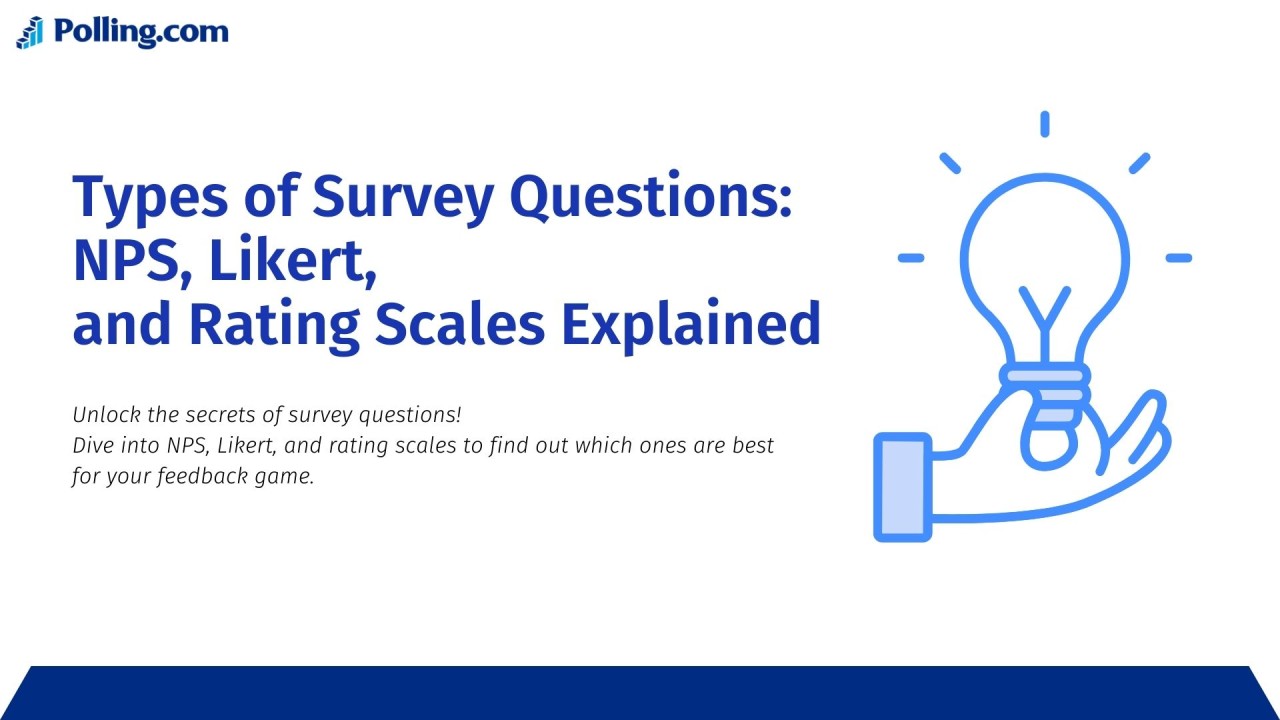
Types of Survey Questions: NPS, Likert, and Rating Scales
Ratings are a popular way to ask questions in surveys because they are simple and easy for people to answer.
They help collect opinions quickly and can show how people feel about something.
There are different types of survey questions with rating scales, such as the NPS (Net Promoter Score) for measuring customer loyalty, Likert scales for capturing levels of agreement, and star ratings for showing satisfaction visually.
Each type helps collect different kinds of feedback, and picking the right type makes the answers more helpful to help businesses make better choices.
Understanding Types of Survey Questions
Survey questions are used to ask people for information, and there are different kinds of questions to get different answers.
Some questions let people say “yes” or “no.”, others let them pick from a list, and some questions allow people to write what they think.
In particular, there is a type of survey question that is considered to fit within the broader survey question framework.
Rating questions are a type of survey question that asks people to give a score or rank to something. These questions fit into the bigger group of closed-ended questions.
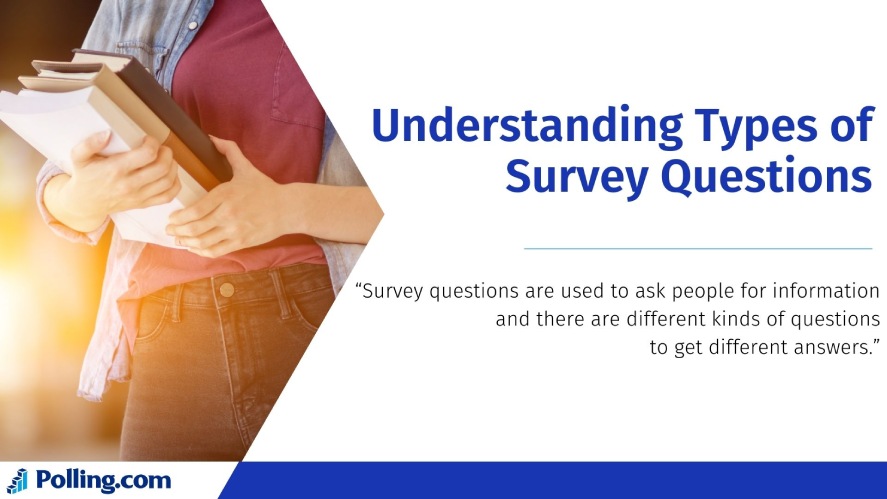
Closed-ended questions have answers that are already chosen, so people just pick or rate from the options.
Rating questions help measure how much someone likes or dislikes something.
For example, a survey might ask how much you like this product, with answers ranging from 1 not at all to 5 love it.
Rating questions are useful because they make it easy to compare answers and see patterns.
Among other online tools, Polling.com is a great platform that helps people create surveys even with all major types of survey questions.
It includes rating scales, where people can choose a number or level to show how much they agree or like something.
Additionally, Polling.com makes it easy to ask questions and get answers from others.
Whether you want to ask simple yes/no questions or let people rate things from 1 to 10, this platform can do it all.
Types of Rating Questions in Surveys
Rating questions play a crucial role in surveys, offering insights into customer opinions and experiences.
We’ll explore six different types of survey questions, each designed to serve diverse purposes and gather meaningful feedback.
1. Net Promoter Score (NPS)
Net Promoter Score (NPS) is a method that helps you understand how satisfied your customers are.
You can pose a simple question to assess customer satisfaction by asking how likely they are to suggest your service or product to a friend or colleague, with respondents answering on a scale from 0 to 10.
On this scale, a rating of 0 shows that there is little to no likelihood of recommending it, whereas a rating of 10 reflects a strong likelihood of making a recommendation.
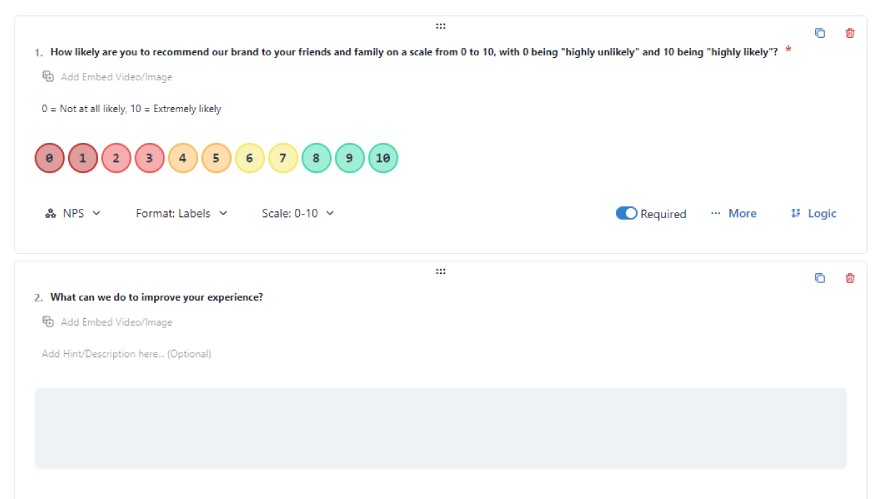
NPS scale is useful for many things, like customer satisfaction surveys, checking how strong a brand is, and finding out if customers will keep coming back.
You can use an NPS score to see if your customers are happy and how they feel about the company.
When most people give high ratings, it reflects that your company is doing a good job. On the contrary, low ratings from many people highlight areas that require improvement.
Moreover, an excellent feature of NPS is that it is user-friendly and straightforward, making NPS management easier for businesses.
It’s just one question, so you can get answers quickly.
Also, since many companies use NPS, your business can compare your NPS rating with others in the same industry.
Thanks to that, you can understand the NPS meaning and know if you are doing better or worse than other companies.
2. Linear Scales
Linear scales are a simple way for companies to collect feedback. They are numeric or verbal scales where people rate something on a line.
For instance, they could evaluate their feelings using a scale from 1 to 5 or 1 to 10.
The numbers displayed on the scale are generally used to represent varying levels, where “1” is commonly associated with the lowest or least intense level, and “10” signifies the highest or most intense level possible.
In addition, linear scales are very flexible and can be used for many things.
Companies can use them to measure how satisfied people are with a product, the importance of a particular factor, or how much they agree with an idea.
These scales work well for customer surveys, employee feedback, or even classroom polls because they are simple to use and easy to understand.
In many cases, the straightforward nature of linear scales is recognized as a benefit for participants.
People just choose a number that matches their opinion, and that’s it!
Also, these scales give detailed data, so companies can see small differences in how people feel.
Consequently, a linear scale survey is great for spotting trends or patterns in responses.
A business might ask, “Rate your satisfaction with our service on a scale from 1 to 10, where 1 means ‘Very Unsatisfied’ and 10 means ‘Very Satisfied’.”
Like other tools, you can quickly see if your customers are happy or if there are problems you need to fix.
Therefore, linear scales are considered a useful tool for improving services and products.
3. Star Ratings
Star ratings are a widely used method that allows people to provide feedback on products, services, or experiences, offering a simple yet effective way to express their opinions.
In this system, customers evaluate items by assigning stars, typically ranging from 1 to 5, where one star indicates a “very bad” experience and five stars represent an “excellent” rating.
This method works best for feedback about products, services, or entertainment.
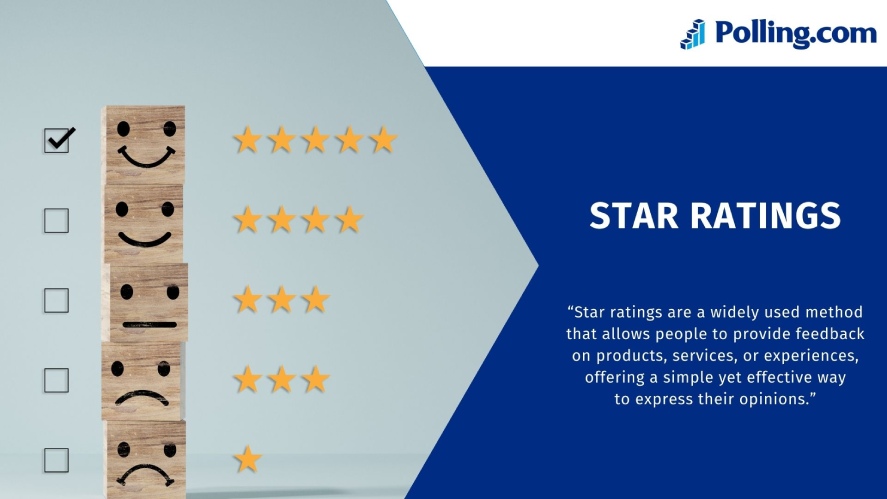
As an example, when people shop online, they might see star ratings for items like books or electronics.
Restaurants and hotels often use star ratings, too, so customers can share how much they enjoyed their experience.
By looking at these ratings, you can learn what your customers like and what needs improvement.
Star ratings enchant users not just with their vibrant visuals but also with their remarkably clear and intuitive format.
When people see stars, they instantly know what the feedback means without needing to read a lot of text. This makes star ratings great for quick surveys or reviews.
Many businesses also use these ratings to compare themselves with competitors and to showcase high ratings as a sign of quality.
Just imagine a restaurant asking its customers to “Rate your overall dining experience.”
If most customers give five stars, it means the restaurant is doing a great job. But if many people give one or two stars, the restaurant can use that feedback to figure out what went wrong and improve.
Star ratings help businesses grow by showing them what works and what doesn’t.
4. Likert Scales
A Likert scale is a widely used tool designed to measure people’s opinions, attitudes, or feelings about a particular subject, providing a range of response options that help quantify the intensity of their views.
It usually has 5 to 7 points, such as “Strongly Agree” to “Strongly Disagree.”
Likert scales allow businesses, schools, or researchers to understand the extent of someone’s agreement, the frequency of an event, or the level of importance attached to something.
Researchers also use them to understand opinions on different topics.
The answers give clear details about how people feel, which can help make decisions or improvements.
One great thing about Likert scales is that they allow people to give more detailed answers than just “yes” or “no.”
To give an example, someone might choose “Agree” instead of “Strongly Agree” to show they like something, but not too strongly.
It provides the person collecting the answers with a clearer understanding of how people feel.
For instance, a company might ask its employees, “I feel valued at my job,” with a scale from 1 (Strongly Disagree) to 5 (Strongly Agree).
In cases where most employees choose 4 or 5, the company can infer that the workers feel appreciated.
Conversely, in cases where many select 1 or 2, it indicates that the company needs to implement changes to help employees feel more valued.
5. Semantic Differential Scales
Semantic Differential Scales are a way to understand people’s opinions by letting them pick a spot between two opposite words.
To illustrate, they could be asked to rate their experience by choosing between the options convenient or inconvenient.
The scale can show if someone feels closer to one side or the other or if they feel neutral.
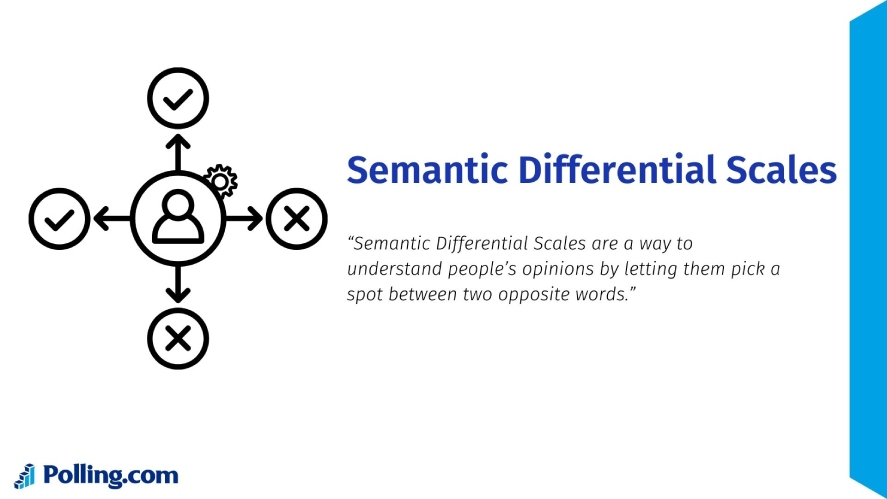
This method is very useful for measuring things like how people see a brand, how good a service is, or how they feel emotionally about something.
Companies can use it to find out if customers think their service is friendly or unfriendly, fast or slow, and so on. It gives a clear picture of what customers like or dislike.
A major advantage of Semantic Differential Scales is that they clearly highlight significant differences in opinions.
Instead of just asking do you like this, the scale shows how much someone likes or dislikes something.
Such information allows you to gain a deeper understanding of your customers’ feelings and make better decisions for improvement.
There are many survey question examples, such as a company asking people to describe their experience, allowing them to select between convenient and inconvenient.
Should many people choose convenience, the company can conclude they are performing well. However, if people select inconvenient, it signals that the company needs to address certain issues.
Thus, Semantic Differential Scales make it easy to see where improvements are needed.
6. Thumbs Up/Down
Thumbs Up/Down is a quick and easy way to get feedback from customers.
It is a simple rating system where people can either give a “thumbs up” to show they liked something or a “thumbs down” to show they didn’t like it.
The effectiveness of this method comes from its simplicity and the fact that it requires only a second for users to provide a response.
Additionally, the feedback system is best used when companies need quick evaluations.
It works great for checking if people like a product, enjoyed reading an article, or had a good experience with customer service.
Since the system is so fast and easy, it encourages more people to share their opinions without feeling like it’s a big task.
A key benefit of the Thumbs Up/Down system lies in its straightforward nature, making it easy for users to express their opinions quickly and efficiently.
Users don’t have to think too much or answer long questions. They can just click one button to share how they feel.
So it will be a good choice for getting a lot of feedback quickly and easily.
On websites or apps, you might see a question like, “Was this article helpful?” with a thumbs-up and thumbs-down button.
When most users click the thumbs-up, it indicates that they found the article useful. On the other hand, when many click the thumbs-down, it suggests that the website should focus on improving the content.
As a result, businesses can understand what people like or don’t like in a very simple way.
Choosing the Right Types of Survey Questions
When creating a survey, it is essential to select the appropriate rating scale, as the right one can help gather clear and useful feedback from participants.
The first thing to think about is the purpose of your survey.
Different scales work better for different kinds of data because each scale is designed to capture specific types of information more accurately.
To put this into perspective, the Net Promoter Score (NPS) works well for measuring customer loyalty, while a Likert scale is good for understanding people’s attitudes or opinions.
So, picking the right scale will help you collect useful information.
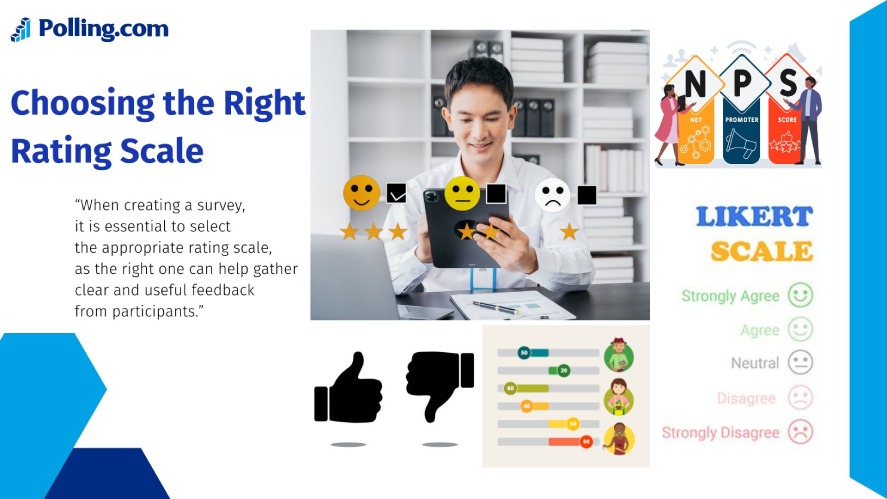
Another thing to consider is your audience.
Some rating scales are more interesting and engaging for certain groups of people.
Special audiences, such as young audiences, might prefer star ratings because they are fun and easy to use.
So, choosing a scale that your audience likes will make them more likely to complete the survey.
You should also think about the length of your survey.
If your survey is short, it’s better to use simple scales like a thumbs-up or thumbs-down.
These scales can help you receive quick survey answer choices, helping you gather more responses in a short amount of time.
Finally, make sure the rating scale works well with the tools you are using.
Especially when you are using a platform like Polling.com, check that the scale fits smoothly into the system.
Due to this, you can avoid technical problems and make sure your survey is easy to complete.
Tips for Designing Effective Rating Questions
Ensuring that when you make rating questions for surveys, you better design them well so they are easy to understand and give good information.
You should consider using the same kind of scale for all your surveys.
In simple terms, if you use a scale from 1 to 5 in one survey, use the same scale in other surveys.
With this tip, you may find it easier to compare answers and understand the results.
Another tip is to avoid confusing or overlapping scale points. Each choice on the scale should be clear and different from the others.
For example, instead of using words like “okay” and “average,” which might seem similar, use clearer options like “fair” and “good.”
Thus, people can understand it clearly and pick the best answer without confusion.
Before you send out the survey, test your rating scales to make sure they make sense.
You can ask a few people to try answering the questions.
If they find something unclear, you can fix it before giving the survey to a large group.
Finally, you can include open-ended questions in your survey to gather more detailed information and insights from respondents.
In a specific situation, for example, after someone gives a rating, ask, “Why did you give this rating?”
This way, people can explain their answers, and you can learn more about their opinions.
Conclusion
In conclusion, picking the right rating scale is crucial because it helps you get clear and useful answers in your surveys.
With Polling.com, you will find it simple to create different kinds of rating questions using free polling tools and easy tools and helpful templates.
Check out Polling.com now to explore all the rating scales and templates you can use to make great surveys!
